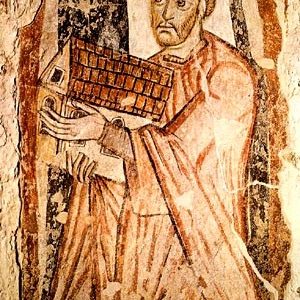With so much talk lately about the Gospels, I wonder, who wrote the Gospels and how do we know?
To answer this question we must first be clear on how the Gospels were formed and what constitutes authorship. Citing Vatican II’s Dogmatic Constitution on Divine Revelation (Dei Verbum), the Catechism has a very succinct presentation on the formation of the Gospels (cf. No. 125-127). The foundational premise is that
Holy Mother Church has firmly and with absolute constancy maintained and continues to maintain, that the four Gospels [Matthew, Mark, Luke and John], whose historicity she unhesitatingly affirms, faithfully hand on what Jesus, the Son of God, while He lived among men, really did and taught for their eternal salvation until the day when He was taken up. (Dei Verbum, No. 19)
After the ascension of Jesus, the Apostles went forth preaching the Gospel, handing on to others what our Lord had done and taught. Having been instructed by the Lord and then enlightened by the Holy Spirit, they preached with a fuller understanding. Eventually, the “sacred authors” wrote the four Gospels. Each author, guided by the Holy Spirit, selected from the events and teachings of our Lord which perhaps they had witnessed or which had been handed on either orally or in written form.
Sometimes the authors may have synthesized some of these events or teachings, or may have underscored parts or explained parts with a view to a certain audience. This is why the Gospels oftentimes tell the same story, but each will have certain details not included by the others. In a similar way, if each member of a family had to write a family history, each member would tell basically the same story, but each member would also highlight certain details he considered important and would keep in mind who would be reading the family history. Nevertheless, the sacred authors wrote “in such a fashion that they have told us the honest truth about Jesus” (No. 19). Therefore to suggest that the third-century Church “wrote” the Gospels in some kind of vacuum, almost to “create” Jesus, is without foundation.
So did Sts. Matthew, Mark, Luke and John write the Gospels? Is the sacred author also the saint? Remember only St. Matthew and St. John were among the Twelve Apostles. We must keep in mind that in the ancient world, authorship was designated in several ways: First, the author was clearly the individual who actually wrote the text with his own pen. Second, the individual who dictated the text to a secretary or scribe was still considered the author. Third, the individual was still considered the author if he only provided the ideas or if the text were written in accord with his thought and in his spirit even though a “ghost writer” did the actual composition. In the broadest sense, the individual was even considered the author if the work was written in his tradition; for example, David is given credit for the Psalms even though clearly he did not write all of the Psalms.
Whether the final version of the Gospels we have is the word-for-word work of the saints [they are named for] is hard to say. Nevertheless, tradition does link the saints to their Gospels. St. Mark, identified with the Mark of Acts 12:12 and the Mark of I Peter 5:13, is mentioned in a quote contained in a letter from Papias (c. 130), Bishop of Hierapolis: “When Mark became Peter’s interpreter, he wrote down accurately, although not in order, all that he remembered of what the Lord had said or done.” St. Irenaeus (d. 203) and Clement of Alexandria (d. 215) support this identification. The Gospel of Mark is commonly dated about the year 65-70 in conjunction with the destruction of the Temple of Jerusalem.
St. Matthew is identified with the tax collector called as an Apostle (Mt 9:9-13). Papias again attests to the saint’s authorship and indicates that he was the first to compile a collection of Jesus’ sayings in the Aramaic language. For this reason, the Gospel of Matthew, at least in a very basic form in Aramaic, is considered the first Gospel and placed first in the New Testament, although the Gospel of Mark is probably the first in a completed form. St. Irenaeus and Origen (d. 253) again support this authorship. Nevertheless, some scholars doubt the saint’s direct authorship because we only have the Greek version, not the Aramaic, and no citations are made from the Aramaic version in Church literature. The version of the Gospel we have was probably written between 70-80.
St. Luke, the beloved physician and disciple of St. Paul (Col 4:14), has consistently been recognized in Christian tradition as the author of the third Gospel, beginning with St. Irenaeus, Tertullian (d. 220) and Clement of Alexandria. The Gospel [has long been assumed to have been] written about 70-80.
St. Irenaeus identified the author of the fourth Gospel as St. John the Apostle. He does so based on the instruction of his teacher, St. Polycarp (d. 155), who himself was a disciple of St. John. Throughout this Gospel, the numerous details indicate the author was an eyewitness. Also scholars generally agree that “the beloved disciple” mentioned in the Gospel is St. John. This Gospel was written probably about 80-90.
Whether the actual saint wrote word-for word, whether a student did some later editing, or whether a student actually wrote what had been taught by the saint, we must remember the texts — whole and entire — are inspired by the Holy Spirit. Yes, the human authors used their skills and language with a view to an audience; however, they wrote what God wanted written. The Dogmatic Constitution on Divine Revelation clearly asserted,
Since, therefore, all that the inspired authors, or sacred writers, affirm should be regarded as affirmed by the Holy Spirit, we must acknowledge that the books of Sacred Scripture firmly, faithfully, and without error, teach that truth, which God, for the sake of our salvation, wished to see confided to the Sacred Scriptures. (No. 11)
So no matter who actually put the finishing touches on the sacred Scriptures, each is inspired.
Interestingly, with the recent scholarship on the Dead Sea Scrolls, new evidence points to the authorship of the traditional authors. Rev. Reginald Fuller, an Episcopalian and Professor Emeritus at Virginia Theological Seminary, with Dr. Carsten Thiede, has analyzed three papyrus fragments from the 26th chapter of the Gospel of Matthew; the fragments date to the year 40, which would indicate that the author was an eyewitness to our Lord’s public ministry. Father Jose O’Callaghan, S.J., studying fragments of the Gospel of Mark and using paleographic means, dated them at 50, again indicating an eyewitness author. Finally, Episcopalian Bishop John Robinson also posited from his research that all four Gospels were written between 40 and 65, with John’s being possibly the earliest. This new research is not only questioning some of the modern scholarship [and dating] but also supporting the traditional authorship.
Perhaps some mystery surrounds these texts and the identity of the authors. Nevertheless, we hold them as sacred, as inspired and as truly the Word of God.
One last point: Given the blasphemous book The Da Vinci Code and its promotion of the Gnostic gospels, why were the Gospels of Matthew, Mark, Luke and John included in the canon of the New Testament and no other supposed gospels? The simple reasons for their inclusion is as follows: First, the Gospels of Matthew, Mark, Luke and John are rooted in the apostolic tradition and can be attributed to apostolic authorship, as noted above. Second, these Gospels are orthodox in their teaching, particularly about the identity and person of Jesus. Third, they were used in the Mass and other liturgical functions. Fourth, they were accepted by the whole Church, not just by some sect. The Gnostic gospels do not fit any of these criteria, and therefore were rejected and condemned by the Church.












